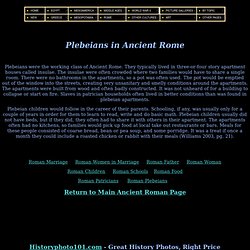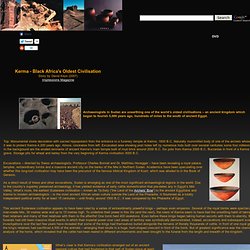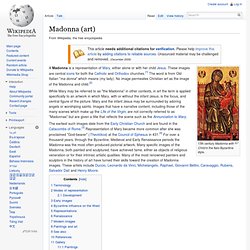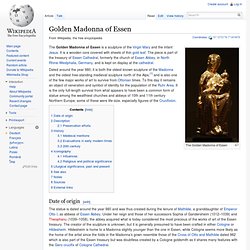

Visual History of War, Religion, and Government. Plebeians in Ancient Rome. Plebeians were the working class of Ancient Rome.

They typically lived in three-or-four story apartment houses called insulae. The insulae were often crowded where two families would have to share a single room. There were no bathrooms in the apartments, so a pot was often used. The pot would be emptied out of the window into the streets, creating very unsanitary and smelly conditions around the apartments.
The apartments were built from wood and often badly constructed. Plebeian children would follow in the career of their parents. Roman Marriage Roman Women in Marriage Roman Father Roman Woman Roman Children Roman Schools Roman Food Roman Patricians Roman Plebeians Return to Main Ancient Roman Page Historyphoto101.com - Great History Photos, Right Price Follow our updates on Facebook or Twitter Pictures on this page are for viewing only. Please see Pictures Galleries for Royalty Free images for Educational uses. Copyright © 2000-2014 All Rights Reserved History Source LLC. Lost Civilization May Have Existed Beneath the Persian Gulf - Yahoo! Veiled beneath the Persian Gulf, a once-fertile landmass may have supported some of the earliest humans outside Africa some 75,000 to 100,000 years ago, a new review of research suggests.

At its peak, the floodplain now below the Gulf would have been about the size of Great Britain, and then shrank as water began to flood the area. Then, about 8,000 years ago, the land would have been swallowed up by the Indian Ocean, the review scientist said. The study, which is detailed in the December issue of the journal Current Anthropology, has broad implications for aspects of human history. For instance, scientists have debated over when early modern humans exited Africa, with dates as early as 125,000 years ago and as recent as 60,000 years ago (the more recent date is the currently accepted paradigm), according to study researcher Jeffrey Rose, an archaeologist at the University of Birmingham in the U.K. Watery refuge Ironclad case? And there's a hint of mythology here, too, Rose pointed out. Oldest evidence of arrows found. 26 Август 2010Last updated at 09:22 By Victoria Gill Science reporter, BBC News The stone points are approximately 64,000 years old Researchers in South Africa have revealed the earliest direct evidence of human-made arrows.

The scientists unearthed 64,000 year-old "stone points", which they say were probably arrow heads. Closer inspection of the ancient weapons revealed remnants of blood and bone that provided clues about how they were used. The best AMERICAN and GERMAN news finder. Archaeological news: Latest from the world of the past. South America's Oldest Writing System: Ancient Quipu Found at Caral. Kerma - Black Africa's Oldest Civilization. Kerma - Black Africa's Oldest Civilisation Story by David Keys (2007) Top: Monumental stone decoration with sacred hippopotami from the entrance to a funerary temple at Kerma, 1600 B.C.

Naturally mummified body of one of the archers whose job it was to protect Kerma 4,200 years ago. Above, clockwise from left: Excavated area showing post holes left by numerous huts built over several centuries some four millennia ago. In the background are the eroded remnants of ancient Kerma’s main temple built of mud brick around 2000 B.C. Archaeologists in Sudan are unearthing one of the world’s oldest civilisations – an ancient kingdom which began to fourish 5,000 years ago, hundreds of miles to the south of ancient Egypt. Excavations – directed by Swiss archaeologists, Professor Charles Bonnet and Dr. As a direct result of these and other excavations, Sudan is emerging as one of the most significant archaeological regions in the world. I put Egypt above every other land.”
Custom Search. Madonna (art) 13th century Madonna with Child in the Italo-Byzantine style.

A Madonna is a representation of Mary, either alone or with her child Jesus. These images are central icons for both the Catholic and Orthodox churches.[1] The word is from Old Italian "ma donna" which means (my lady). No image permeates Christian art as the image of the Madonna and child.[2] While Mary may be referred to as "the Madonna" in other contexts, in art the term is applied specifically to an artwork in which Mary, with or without the infant Jesus, is the focus, and central figure of the picture. Mary and the infant Jesus may be surrounded by adoring angels or worshiping saints. "Madonna" is a medieval Italian term for a noble or otherwise important woman, and has long been used commonly in reference to images of the Virgin Mary. Golden Madonna of Essen. The Golden Madonna of Essen The Golden Madonna of Essen is a sculpture of the Virgin Mary and the infant Jesus.

It is a wooden core covered with sheets of thin gold leaf. The piece is part of the treasury of Essen Cathedral, formerly the church of Essen Abbey, in North Rhine-Westphalia, Germany, and is kept on display at the cathedral. Date of origin[edit] Description[edit]
Beyond bones & stones. Timeline of History: 4.3 million Years Ago to 2010.